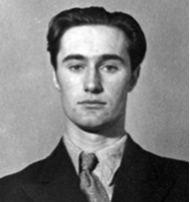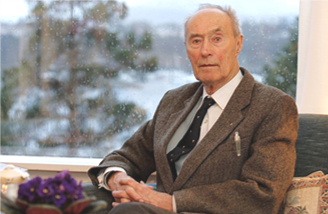

Tower and Town, May 2019 (view the full edition) (view the full edition)Makerel Sky Over TelemarkDetails of key events can surprisingly come to light through tapping into some overlooked linking. This is the framework adopted in this article in which I aim to breathe life into an overlooked heavy water linking from when the World was at war. Welcome to the real world of network science and complexity, firstly popularised through fiction by the 'Six Degrees Separation', (John Guare 1992), and the 'Butterfly Effect (as in The Sound of Thunder)', (Ray Bradbury 1942). On 21 October 2018 the living legend of Telemark was finally claimed by history at the age of 99; and it is his own history that is here narrated for the first time through the prism of the small World in which action somewhere could shape destinies elsewhere. The product is a story that revolves around two seemingly unrelated protagonists, who belong to different generations, and yet linked through water-related events in 1932. Harold Clayton Urey, (1893-1981), was a son of small town, pre-industrial America; he once told colleagues that the first time he saw an automobile was at age 17 in rural Montana. After graduating from high school, he taught in small country schools in Indiana for three years, before working his way through the University of Montana. His original intention was to study psychology. He actually majored in zoology, combining it with chemistry courses. During WWI he worked as an industrial chemist, and then entered graduate school late in life at age 28.   The Norwegian Joachim Rønneberg, (1919-2018) grew up in Ålesund, a shipbuilding town in north-western Norway; and remained living with his parents as a young adult whilst working for a fish exporting company. Why 1932? The year 1932 is considered special in the annals of nuclear physics; and its events subsequently proved life changing for the then 13 years old Joachim Ronneberg.. The events include neutron and atom splitting discoveries at the Cavendish Laboratory in Cambridge, plus the discovery of deuterium, (heavier hydrogen isotope whose nucleus comprises 1 proton plus 1 neutron), by our first protagonist who was by then Professor Urey of the University of Colombia in New York. These discoveries merited Nobel Prizes, including Chemistry (1934) for Urey. Why Heavy water Good science is more about curiosity, and that was the primary motivation that led to the deuterium discovery by Harold Urey. However in order to appreciate the enormity of this I have to remind you that a normal water molecule, H2O, consists of two atoms of hydrogen bonded to a single oxygen atom. Similarly, the bonding of two atoms of the heavier deuterium with one atom of oxygen forms a heavy water molecule, which can be also called deuterium oxide D2O. Moreover, bulk heavy water is defined as water containing predominantly D2O molecules. Now it so happened that later on heavy water, which can be distilled from sea water, proved to be vital for the production of nuclear weapons This finally brings us to a significant juncture in the unfolding of our story; and that is the 1935 commencement of commercial heavy water production at the recently commissioned Rjukan plant in southern Norway, (then the world's largest hydroelectric power plant). When War Came to Ålesund As a young man Joachim Rønneberg was still living with his family whilst employed by the fish export company at Ålesund. Then his world fractured when the Germans advanced on Norway and became occupiers by 4 April 1940. Within two months the armed resistance collapsed, and resentment of the occupier grew. Ten months later, this led the 20 years old Joachim Rønneberg, to join eight friends on an escape to Britain using a fishing boat. Armed with his clear moral compass, self-control, and physical fitness, he then passed difficult tests and managed to get recruited for the Special Operations Eexecutive, the secret organisation that Churchill had set up to conduct sabotage missions behind enemy lines. Based in Cambridgeshire, he underwent rigorous training and was promoted to a trainer. One day in December 1942 he was summoned to London. He was to select, train and lead a team of five on a secret high risk mission in occupied Norway. The exact purpose of the mission was not disclosed. Decision to Destroy As WWII raged there were growing debates within the scientific and political circles about the capabilities and intentions of German nuclear research, including efforts to secure heavy water supplies from the Norsk hydroelectric plant (named Vemork) near Rjukan within the Telemark region in southern Norway. This brought Churchill onto the scene and a decision to destroy the plant was made. Special Moment at Telemark Joachim Rønneberg was eventually briefed on operation Gunnerside to place explosive charges on the massive water electrolysis chambers of the Rjukan plant, and his team started training in earnest on a model based on drawings secured by British Intelligence. Members of the team were convinced that this would be a one way mission but they were consoled by the fact that they were in it together. Then the mission day arrived and the RAF plane circled high above the Telemark Mountains. The six parachutists, camouflaged in white smocks, were then dropped off just after midnight on 17 February 1943. However they soon found out that they were in the midst of a storm in temperatures of -20C and some eighteen miles off target. Nevertheless, the team persevered and eventually rendezvoused six days later with the reception committee of two before setting off at 8pm skiing through the pine forest that leads to the ravine where the hydro plant nestled on the mountainside. They arrived exhausted at 11:45pm, worked out a strategy, and then left their radio operator behind and proceeded to slide down the opposite wild, windswept mountainside, and then to swim across a freezing river in order to reach their target. When the 30 seconds timer went off they were on their way to safety well before the Germans found out. The sun came up at 6am whilst they were in the mountains. "It was a mackerel sky," said Rønneberg. "It was a marvellous sunrise. We sat there very tired, very happy. Nobody said anything. That was a very special moment." The raid was successful and although 3,000 German soldiers were dispatched to search the area for the commandos, all of them escaped; five of them skied 400 kilometres to neutral Sweden. Closing Curtains Over seventy years later a day came along when the true leader made his final departure. Having survived all the members of his team, Joachim Rønneberg finally passed away aged 99 in a nursing home on 21 October 2018, a legend in his lifetime. Not a small feat for a boy from Ålesund who was only 13 when heavy water first came to light, who became a hero at 24, and who carried with him till the end a steadfast moral compass, "People must realise that peace and freedom have to be fought for every day."  Raik Jarjis |